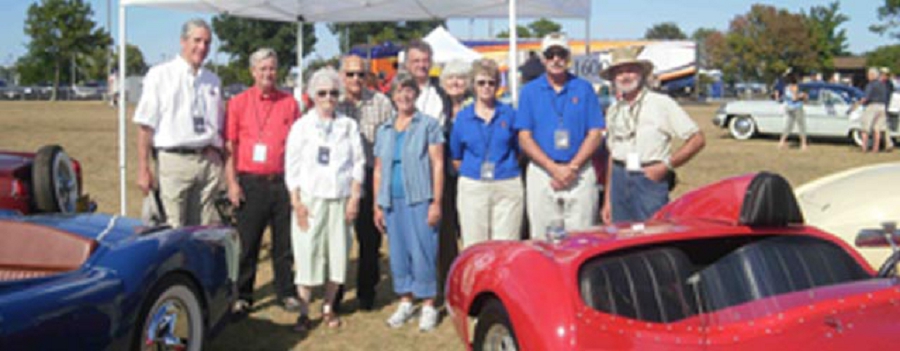
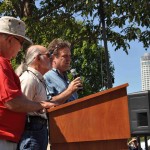
Here Merrill Powell, Co-Owner of Victress in the 1950’s, Speaks To The Crowds About The Early Days of Glass.
Hi Gang…
Let no one say that vintage fiberglass is long gone and forgotten.
Actually….I can’t think of a more exciting category of cars that is rising in fame, interest, respect, and celebration as quickly as our glass beauties. “Let no fiberglass stone go unturned” in our quest to share the story of glass and the fantastic cars that were conceived, designed, built, raced, and admired from the 1950s forward. And the latest event recognizing these cars just wrapped up in Wisconsin on Sunday August 28th, 2011 – The Milwaukee Masterpiece Concours d’Elegance.
What’s Been Happening in Fiberglass:
This event is one that we’ve been building toward in recent years, and is the result of all of you pulling together and helping us recognize these special cars in every way. The progression of events over the past few years goes something like this:
- 2007: Amelia Island Concours d’Elegance
- 2008: Palo Alto Concours d’Elegance
- 2008: Barrington Concours d’Elegance
- 2009: (Research Year – Geoff goes to Bonneville and finds a Mysterion…)
- 2010: Amelia Island Concours d’Elegance
- 2010: Petersen Automotive Museum Celebration
And now….
- 2011: Milwaukee Masterpiece Concours d’Elegance
All of the events above recognized fiberglass sports cars of the 1950’s and beyond in very special ways. Our latest event was the result of two people with a shared vision – DeWayne Ashmead (noted collector and historian) and Leon Flagg (Chairman of the Milwaukee Masterpiece). These two folks deserve special recognition for making our fiberglass celebration in Milwaukee happen in every way.
Let’s Talk About the Program:
I think the best way to share the story of fiberglass at “The Masterpiece” is to tell it over a few articles. Let’s share the Milwaukee Masterpiece Program first. I have
uploaded the images into our photo gallery at the bottom of this story for your review. In addition, with the help of our noted webmaster, Shannon Smith, we are trying a new feature in this story. It’s a digital book of the pages of the program.
What you’ll notice as you go thru the pages is that our fiberglass feature was divided into three classes of cars showing 6 cars each:
- Class 1: Famous Fiberglass
- Class 2: Forgotten Fiberglass I
- Class 3: Forgotten Fiberglass II
We even had a class dedicated for a very special car owned by Myron Vernis called the Paxton Phoenix. The class for this car – a Brooks Stevens designed car – was called “A Class By Itself.” This gave us a total of 19 fiberglass cars at the event.
Click the link below to see this new feature and send me an e-mail to let me know if you like or dislike this new way of presenting printed material. I’m going to be using this approach for more stories if it works well. Click on the image of an open book below to begin reviewing the digital book on the Milwaukee Masterpiece. It will open in a separate window on your desktop.
[book id=’6‘ popup=’1′ preview=’https://www.undiscoveredclassics.com/wp-content/uploads/2011/09/13991/book.jpg‘/]

Here Tom Keeney of the Petersen Museum Shares A Moment With Former Bosley Mark I Owner Bill Hebal. Tom’s Holding One Of The Original Models Of The Car Built By Richard Bosley in the 1950’s.
Fiberglass Masterpieces – By Harold Pace
Noted author, historian, and collector Harold Pace was kind enough to write a piece about vintage fiberglass cars for the Concours d’Elegance. Although it appears in the program shared with you in this story, I thought it might be easier to review it – reprinted – as part of our article on our website too.
Thanks for such a great article Harold! And now…here’s the article for your review:
Fiberglass isn’t magic. Neither is aluminum, steel or carbon fiber.
They are all materials that car bodies can be built from, and there are very worthy automobiles that have been built from each, and, in many cases, from combinations of these materials. But fiberglass seems to incite the widest range of feelings, ranging from glowing praise to acerbic derision. Fans point to recognized performance icons like the Corvette, while critics bring up the worst excesses of the kit car industry.
The Milwaukee Masterpiece has examples of both ends of the market, from vaunted production models to specialty cars built in single-digit numbers. And all of them are worthy of study.
Fiberglass has many traits that make it ideal for small-volume production, including inexpensive set-up costs and ease of production by inexperienced personnel. But once production grows above a few thousand cars the unit cost can climb higher than investing in conventional steel body presses. There have only been a small number of “volume production” fiberglass-bodied cars, starting with the 1953 Corvette.
Chevrolet kept using fiberglass even when production numbers climbed beyond the break-even point for steel, simply because fiberglass had become synonymous with the Corvette. The 1963 Studebaker Avanti was the next American production car to opt for fiberglass body construction, although in England Lotus had tested the waters in 1958 with the lovely Elite. Kaiser, Briklin, TVR and Ferrari have also built fiberglass-bodied models in significant numbers.
Although fiberglass never took off as clothing for many high-volume manufacturers, it was a godsend to the specialty car market. Low set-up and prototyping costs meant that, starting in the 1950s, any enthusiast with a dream, a garage, some plaster and a roll of chicken wire could go into kit car production for less than the cost of a used Buick. And since then literally thousands of companies have done just that, including recognized makes like Glasspar, Woodill, Devin, Victress, Fiberfab, Kellison, Kurtis and Bruce Myers.
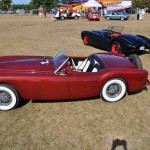
Dick and Jeanette Foster – Original Owners And Builders Of This Wildfire – Showed Their Car For The First Time In Over 50 Years!
These companies built kit cars by the hundreds, and in some cases, thousands. At the other end of the spectrum were tiny operations that only dreamed of someday building a dozen cars. But often they were stunning beauties like the Bosley, El Tiburon, Meteor, LaDawri, Almquist and Byers. Fiberglass was also ideal for crafting one-off bodies for show cars and production prototypes like the Cadillac Le Mans, Chevrolet Astro I and the Paxton Phoenix.
Of course, not every fiberglass car has been an aesthetic, commercial or technical success, but it wouldn’t be fair to judge every steel-bodied car by a Yugo either.
Today fiberglass is still in use by the specialty car industry, accounting for thousands of Cobra and other replica kits, plus the lion’s share of the hot rod body market. The traits that made fiberglass successful in the 1950s are still valid today, with its stronger composite brethren, carbon fiber, the material of choice for purpose-built racing cars used by every Formula One and IndyCar team. Fiberglass is alive and well, and at The Masterpiece you can enjoy the classics that put it on the map!
Summary:
So this is the first of many stories to come focused on the Milwaukee Masterpiece and the cars and people that were there. There’s much to tell and great pictures to share so be on the lookout for these stories as I “go to press” with them soon.
Hope you enjoyed the story, and until next time…
Glass on gang…
Geoff
——————————————————————-
Click on the Images Below to View Larger Pictures
——————————————————————-
- Wow! Fabulous Fiberglass Gets Title Billing on The Cover of “The Masterpiece”
- Dick and Jeanette Foster – Original Owners And Builders Of This Wildfire – Showed Their Car For The First Time In Over 50 Years!
- Here Tom Keeney of the Petersen Museum Shares A Moment With Former Bosley Mark I Owner Bill Hebal. Tom’s Holding One Of The Original Models Of The Bosley Built By Richard Bosley in the 1950’s.
- Here Merrill Powell, Co-Owner of Victress in the 1950’s, Speaks To The Crowds About The Early Days of Glass.
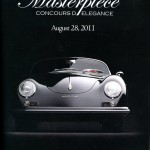

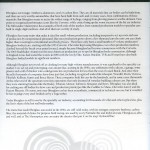
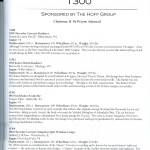
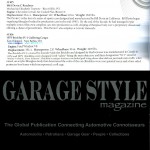
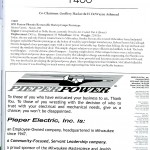
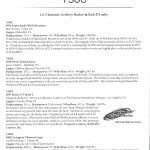
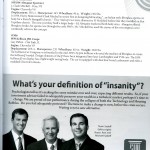
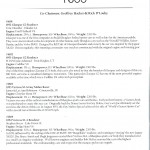
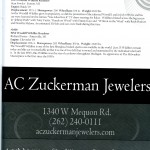
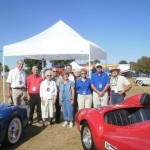


Seems like the Kaiser Darrin is a truly forgotten fiberglass car. To bad not a word about it.
Teri….
You’re right – but it’s not truly forgotten – the pictures we had of it were too overexposed. Did you take any pictures of this car at the Masterpiece we can use? I believe this was your car so hopefully you’ll have some great shots. That would be very helpful, and we could complete a story on the car.
Also, my team has been working on several new articles on the Kaiser Darrin – even the Darrin family is helping with our research. Have you checked out the new articles on the Darrin on our website? Here’s a link to some of the ones we’ve written lately:
https://www.undiscoveredclassics.com/?cat=49
Hope you can help with pictures and have a great day.
Geoff Hacker
Forgotten Fiberglass